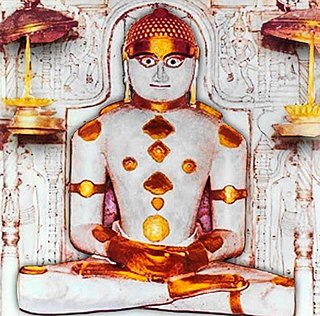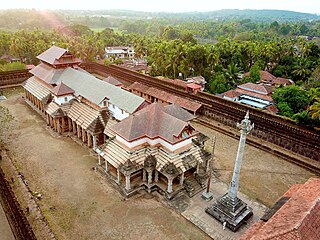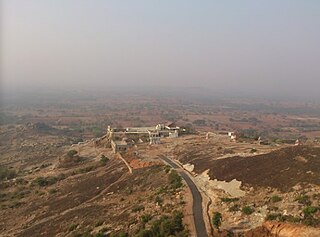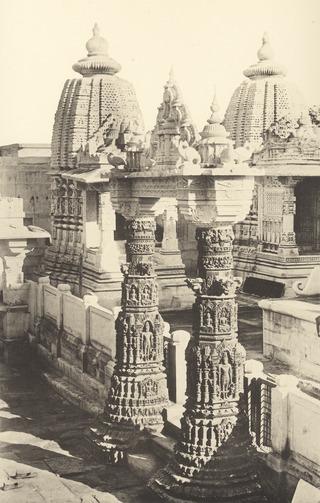Related Research Articles
Jainism, also known as Jain Dharma, is an Indian religion. Jainism traces its spiritual ideas and history through the succession of twenty-four tirthankaras, with the first in the current time cycle being Rishabhadeva, whom the tradition holds to have lived millions of years ago, the twenty-third tirthankara Parshvanatha, whom historians date to the 9th century BCE, and the twenty-fourth tirthankara Mahavira, around 600 BCE. Jainism is considered an eternal dharma with the tirthankaras guiding every time cycle of the cosmology. The three main pillars of Jainism are ahiṃsā (non-violence), anekāntavāda (non-absolutism), and aparigraha (asceticism).

In the Hindu tradition, a murti is a devotional image, such as a statue or icon, of a deity or saint used during puja and/or in other customary forms of actively expressing devotion or reverence - whether at Hindu temples or shrines. A mūrti is a symbolic icon representing Divinity for the purpose of devotional activities. Thus, not all icons of gods and saints are mūrti; for example, purely decorative depictions of Divine figures often adorn Hindu temple architecture in intricately carved doorframes, on colourfully painted walls, and ornately sculpted rooftop domes. A mūrti itself is not God, but it is merely a representative shape, symbolic embodiment, or iconic manifestation of God.

Parshvanath, also Pārśvanātha, Parshva, Pārśva and Parasnath, was the 23rd of 24 Tirthankaras of Jainism. He gained the title of Kalīkālkalpataru.

Rishabhanatha, also Rishabhadeva, Rishabha or Ikshvaku, is the first tirthankara of Jainism. He was the first of twenty-four teachers in the present half-cycle of time in Jain cosmology, and called a "ford maker" because his teachings helped one cross the sea of interminable rebirths and deaths. The legends depict him as having lived millions of years ago. He was the spiritual successor of Sampratti Bhagwan, the last Tirthankar of previous time cycle. He is also known as Ādinātha, as well as Adishvara, Yugadideva, Prathamarajeshwara and Nabheya. He is also known as Ikshvaku, establisher of Ikshvaku dynasty. Along with Mahavira, Parshvanath, Neminath, and Shantinath, Rishabhanatha is one of the five Tirthankaras that attract the most devotional worship among the Jains.

Śhāntinātha or Śhānti is the sixteenth Tīrthaṅkara of Jainism in the present age. According to traditional accounts, he was born to King Vishvasena and Queen Aćira of the Ikshvaku dynasty in the north Indian city of Hastinapur. His birth date is the thirteenth day of the Jyest Krishna month of the Indian calendar. He was also a Chakravartin and a Kamadeva. He ascended to the throne when he was 25 years old. After over 25,000 years on the throne, he became a Jain monk and started his penance.

Karnataka, a state in South India has a long association with Jainism, a religion which enjoyed patronage of major historic kingdoms in the state such as the Rastrakuta Dynasty, Western Ganga, Kadamba and Chalukya dynasties and the Hoysala Empire. Today the state is home to a number of Jain monuments, such as temples, Gommata statues and stambhas.

Saavira Kambada Temple or Tribhuvana Tilaka Cūḍāmaṇi), is a basadi or Jain temple noted for its 1000 pillars in Moodabidri, Karnataka, India. The temple is also known as "Chandranatha Temple" since it honours the tirthankara Chandraprabha, whose eight-foot idol is worshipped in the shrine.

In Jainism, Ambika or Ambika Devi is the yakshini "dedicated attendant deity" or Śāsana Devī "protector goddess" of the 22nd Tirthankara, Neminatha. She is also known as Ambai, Amba, Kushmandini and Amra Kushmandini. She is often shown with one or more children and often under a tree. She is frequently represented as a pair with a small Tirthankar image on the top. The name ambika literally means mother, hence she is Mother Goddess. The name is also a common epithet of Hindu Goddess Parvati.

Jain art refers to religious works of art associated with Jainism. Even though Jainism has spread only in some parts of India, it has made a significant contribution to Indian art and architecture.

Chandraprabha or Chandranatha is the eighth Tirthankara of Tīrthaṅkara of Jainism in the present age. According to traditional accounts, he was born to King Mahasena and Queen Lakshmana Devi at Chandrapuri to the Ikshvaku dynasty. According to Jain texts, his birth-date was the twelfth day of the Posh Krishna month of the Indian calendar. He is said to have become a siddha, a liberated soul which has destroyed all of its karma.

Guru Basadi is a basadi or Jain temple located in Moodabidri town in the Indian state of Karnataka. The Guru basadi is the oldest amongst 18 Jain basadis in Moodabidri built in 714 CE. This temple is near another Jain temple, Saavira Kambada Basadi.

Ponnur Malai Jain temple is an ancient Jain pilgrimage center located in Ponnur Hills in Tiruvannamalai district of Tamil Nadu in India.

Kanakagiri Jain tirth kshetra also known as Kanakadri and Hemantha Desha is situated at about 3 km from Maleyuru, Chamarajanagar district, 53 km from the Mysore city and 182 km from Bengaluru.

Jain Basadi complex in Halebidu, Hassan district consists of three Jain Basadis dedicated to the Jain Tirthankars Parshvanatha, Shantinatha and Adinatha. The complex is situated near Kedareshwara temple and Dwarasamudra lake. The temple complex also includes a step well called Hulikere Kalyani.

The Mahavira Jain temple is built in Osian of Jodhpur District, Rajasthan. The temple is an important pilgrimage of the Oswal Jain community. This temple is the oldest surviving Jain temple in Western India and was built during the reign of Mahārāja Śrī Vatsarāja of Imperial Pratihāras. The temple is visited by both Jain and Hindu.
Panchasara Parshwanath temple is a Jain temple located in Patan, Gujarat. The temple was constructed in 8th century during the reign of Vanaraja Chavda of Chavda dynasty.

The Humcha Jain temples or Humcha basadis are a group of temples found in Humcha village of Shimoga district in Karnataka, India. They were constructed in the 7th century CE in the period of the Santara dynasty and are regarded as one of the major Jain centres of Karnataka. The Padmavati Basadi is the most well-known of these temples.

Kesariyaji Tirth or Rishabhdeo Jain temple is a Jain temple located in Rishabhdeo town of Udaipur District of Indian state of Rajasthan. The temple is considered an important pilgrimage center by both Digambara and Śvētāmbara sect of Jainism.

Danavulapadu Jain temple is an ancient Jain center located in Danavulapadu village of Kadapa district in the state of Andhra Pradesh.
References
- ↑ Shankar, Gowri (15 July 2018). "Nyaya Lingam is a role model for harmony". Deccan Chronicle.
- ↑ "Jain idol unearthed at Banagiri hills". The New Indian Express. 18 December 2020. Retrieved 19 December 2020.
- ↑ Cunningham, Alexander (1879). Report of a Tour in the Central Provinces in 1873-74 and 1874-75. Archaeological Survey of India. Vol. 9. Office of the Superintendent of Government Printing. p. 31.
- ↑ Jain, Vijay K. (2018). Ācārya Umāsvāmī's Tattvārthasūtra – With Explanation in English from Ācārya Pūjyapāda's Sarvārthasiddhi. Vikalp Printers. ISBN 9788193272626.
- ↑ Jaganathan, Rijutha (21 October 2014). "Jain heritage at Kanakagiri". Deccan Herald . Retrieved 30 July 2017.
- ↑ Krishnamachari, Suganthy (12 October 2017), "On how Kongu Nadu was a Jain bastion", The Hindu
- ↑ Rice, Benjamin Lewis (1877). Mysore and Coorg: Mysore. Vol. 1. Mysore: Government Press.
- ↑ Wiley, Kristi L. (2009). The A to Z of Jainism. The A to Z Guide Series. Vol. 38. Scarecrow. ISBN 978-0-8108-6337-8.
- ↑ Chugh, Lalit (2016). Karnataka's Rich Heritage - Art and Architecture (From Prehistoric Times to the Hoysala Period ed.). Notion Press. ISBN 9789352068258.
- ↑ Varma, P. Sujata (1 October 2015). "Ancient Jain temple cries for attention". The Hindu . Retrieved 16 July 2021.
- ↑ Titze, Kurt; Bruhn, Klaus (1998). Jainism: A Pictorial Guide to the Religion of Non-Violence (2 ed.). Motilal Banarsidass. p. 47. ISBN 978-81-208-1534-6.
- ↑ Ramnarayan, Gowri (24 April 2005). "Moodbidri — woods of yore". The Hindu . Chennai. Archived from the original on 26 April 2005. Retrieved 15 July 2018.
- ↑ Cort, John E. (2010), Framing the Jina: Narratives of Icons and Idols in Jain History, Oxford University Press, ISBN 9780195385021
- ↑ Kalia, Asha (1982). Art of Osian Temples: Socio-economic and Religious Life in India, 8th-12th Centuries A.D. Abhinav Publications. ISBN 9780391025585.
- ↑ Jain, Mahima A. (1 February 2016). "Looking for Jina Kanchi". The Hindu. Retrieved 30 November 2019.
- ↑ "Jain Temple Complex". Uttar Pradesh Tourism . Retrieved 2021-01-31.
- ↑ Nandi, Ramendra Nath (1973). Religious Institutions and Cults in the Deccan, C. A.D. 600-A.D. 1000. Motilal Banarsidass. ISBN 978-08-426-0564-9.